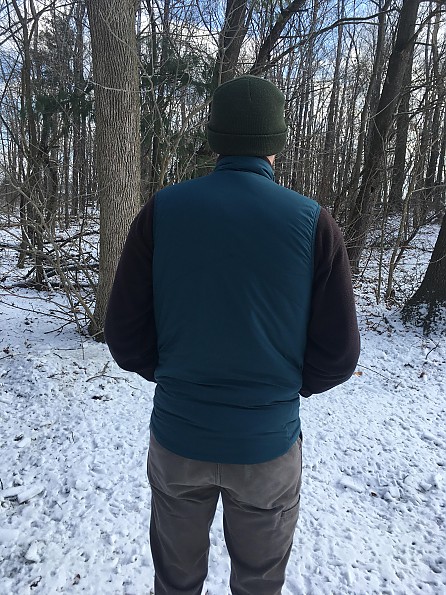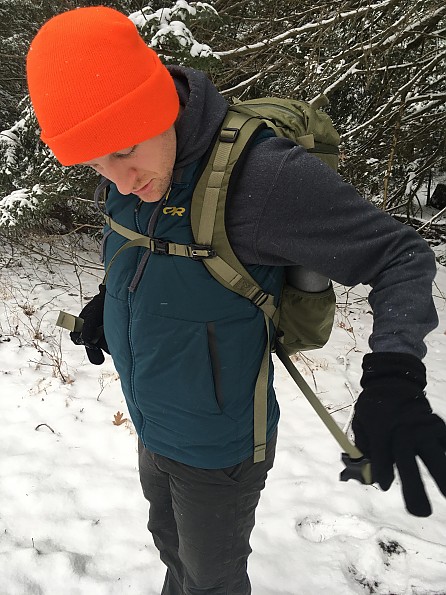Outdoor Research Refuge Vest
The Refuge Vest has been discontinued. If you're looking for something new, check out the best synthetic insulated vests for 2025.

The Outdoor Research Refuge Vest is a do-it-all vest that is well-suited to keep the core warm during chilly winter activities or for adding that extra bit of warmth and comfort during the shoulder seasons when a full-on jacket isn’t necessary. The vest has synthetic insulation (High-loft VerticalX) and with big pockets and a soft, comfortable collar, the vest has some standout features that make it a formidable midlayer or outerlayer.
Pros
- Full coverage of torso
- Breathable
- Adds warmth
- Large hand pockets
- Soft lined collar and pockets
- Easy maintenance
- Bonus feature—makes for a great camp pillow
Cons
- Elastic banded armholes give an unflattering appearance
- Minimal stretch to the fabric
Conditions:
For five months, I’ve regularly worn the Outdoor Research Refuge Vest. This includes through the winter and early spring in Pennsylvania (USA). The vest has been worn as a midlayer during colder days (down to -5°F or -20.5°C) and as an outerlayer on more mild days (up to 60°F or 15.5°C). Activities during which I’ve worn the vest include hiking, camping, and normal everyday use. For the last five months, I’ve worn the vest, on average, two to three times per week.
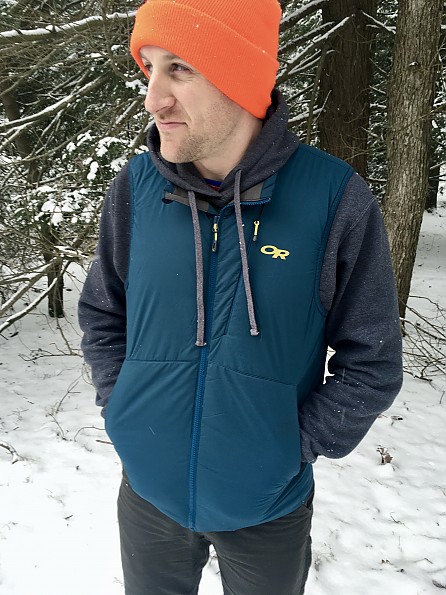
Reviewer’s Measurements:
- Height: 6'2" (74" or 1.88m)
- Weight: 200 lbs (90.7kg)
- Chest: 42.5 inches (108cm)
- Typical Top/Vest Size: Varies between medium and large
- Vest Reviewed Size: Chest size is between Medium and Large, so I sized up to the Large. I think this was a good decision.
Product Notes and Claims:
In addition to the men’s Refuge Vest, there is also a women’s version of this vest (three color options for each), as well as other items in the Refuge collection by Outdoor Research including jackets, various hooded jackets, and pants. All have similar insulation features (High-loft VerticalX insulation) and the manufacturer states, "The Refuge Collection is the pinnacle release of VerticalX, the high-loft insulation that delivers resiliency, breathability, and stretch in a vest that keeps you warm even when wet."
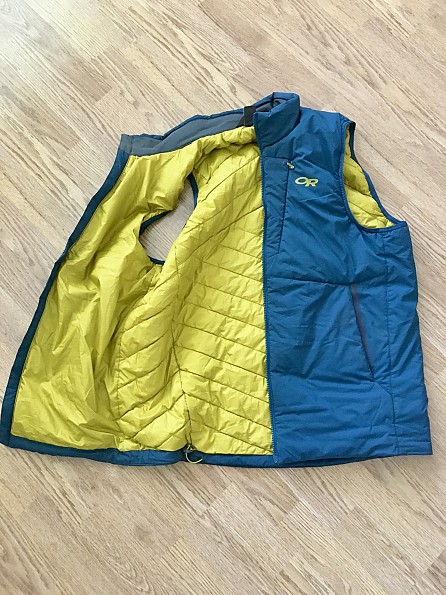
Fit and Comfort:
The vest is sold as a “regular fit” vest. I was worried this might mean it’s boxy and baggy, but that is not the case. It fits well in all areas, including chest, arms, and torso length. It's just a tad bit longer than most other vests I own, which is nice because it covers the butt, even if I bend over to tie my shoe. If you fall in between sizes, I recommend sizing up.
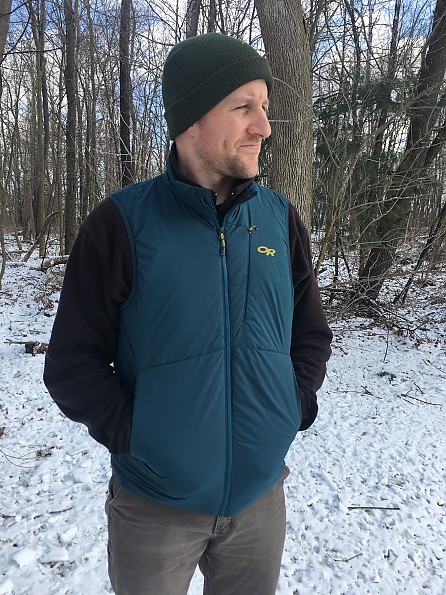

Weight:
10.7oz (303 g) for the men’s size large.
Fabric:
The outer fabric of the Refuge Vest is a ripstop nylon that is wind and water resistant. The manufacturer claims this has a “movement-mirroring stretch,” which sounds cool, but in all practicality, I think the fabric stretch is minimally noticeable and could be increased for added adaptability. The fabric thus far (five months of use) has been durable and shows no signs of wear, strain, or weakness.
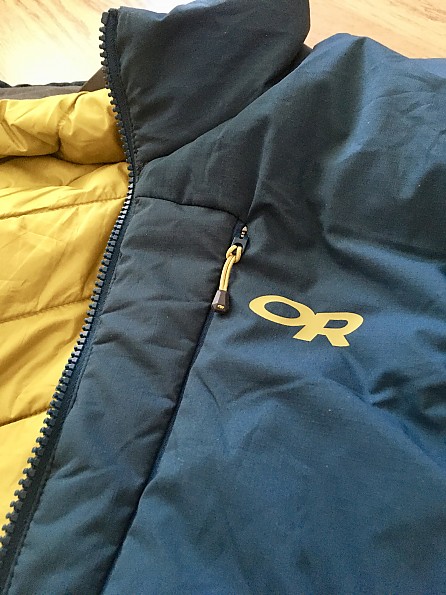
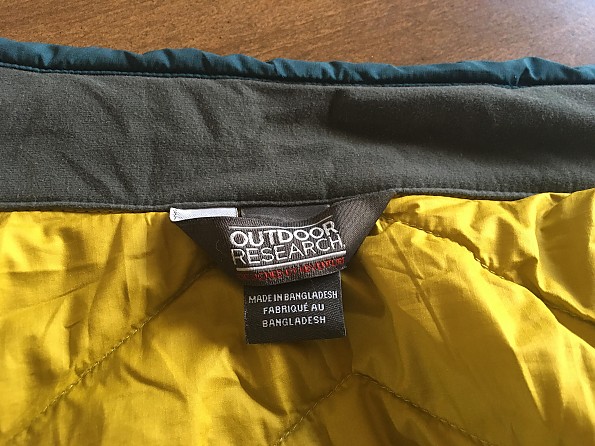
Adjustability:
One elastic drawcord at the hem makes for the ability to seal off the bottom and block out any unwanted drafts. The drawcord is easy to use, but I haven’t needed to do so very often. Over five months of wearing the vest, I think I’ve only cinched down the hem's drawcord a couple times.
Breathability and Warmth:
For its relatively light weight (10.7oz), this vest does a nice job at keeping the body’s core warm but not sweaty, thanks to its insulation (i.e. High-loft VerticalX), elastic banded armholes (i.e. Low-Pro Binding) and thermo-regulating ActiveTemp treatment. Together these make the vest serviceable all winter long, depending on the layering system and activity, of course.
For me, I’ve worn the vest in temperatures ranging as low as -5°F (-20.5°C) as a midlayer and as high as 60°F (15.5°C) as an outerlayer. It’s hard to scientifically quantify or to fully remove other factors such as other layers, but I’d conservatively estimate the vest feels like it adds an additional 10-15F degrees. The only caveat to the ActiveTemp treatment on this vest’s fabric is that this polymer-based technology works best on fabrics that come in contact with the skin, while more often than not, I have a layer or two underneath the vest.
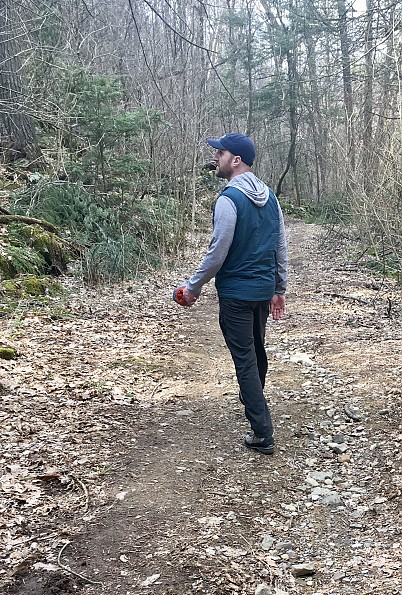
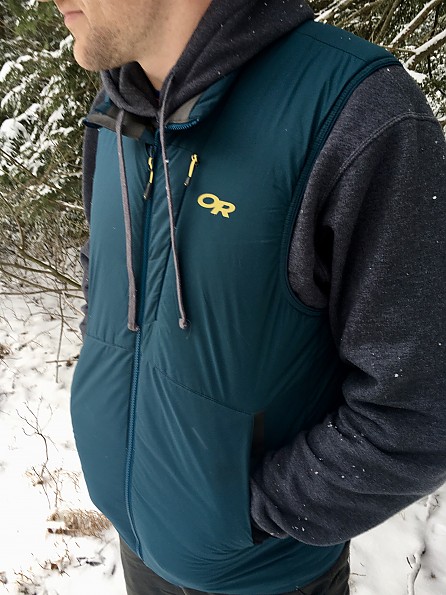
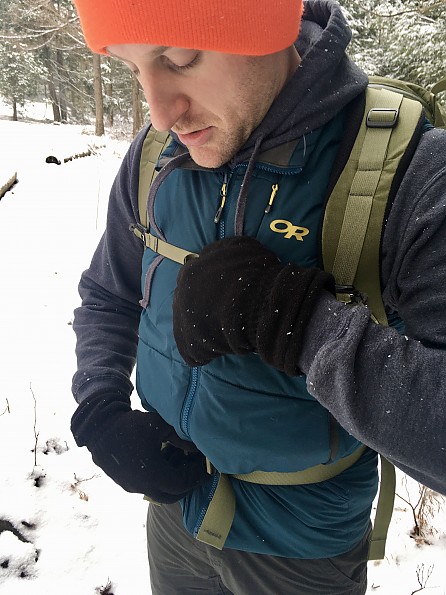
Layering:
The combinations of layers I’ve used with this vest have been too numerous to count. I’ve worn the vest every which way, from a simple approach like a polyester t-shirt underneath and the vest on top (i.e. warm spring weather), to more robust approaches like a merino wool baselayer underneath, followed by a fleece zip-up, then the vest, and finally any number of jackets from down (lightweight) to waxed wool (heavyweight) (i.e. chilly winter weather). In all circumstances, the vest does well as a layer. It doesn’t get in the way and adds warmth without adding much bulk.
The only drawback to using this as an outerlayer is that because of the elastic armholes, it can give a poofy appearance to the arms of the layer directly underneath. Next two photos exemplify the beneath layer poofing out the sides of the arm holes. Doesn't affect function or comfort, but looks a little unflattering.
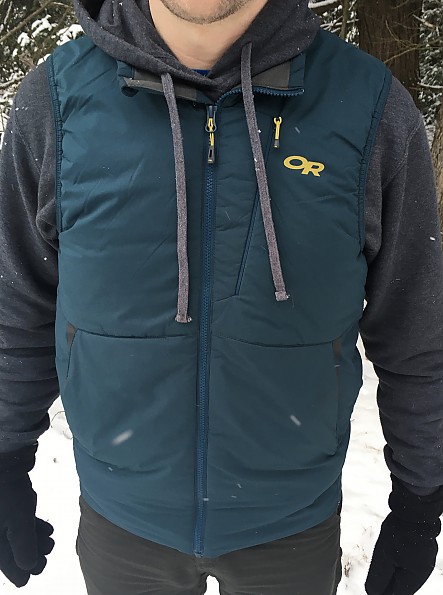
Water Resistance:
A vest being water resistant or waterproof has always been somewhat of a silly idea to me, since it only covers the torso, but nonetheless, this vest does has water resistant functionality. It will keep a light rain at bay or falling snow from soaking through, but in all honesty, if I really need to stay dry, I’m going with a full-sleeved waterproof jacket. The true benefit of this vest’s materials is that, even when wet, it still keeps the body warm.
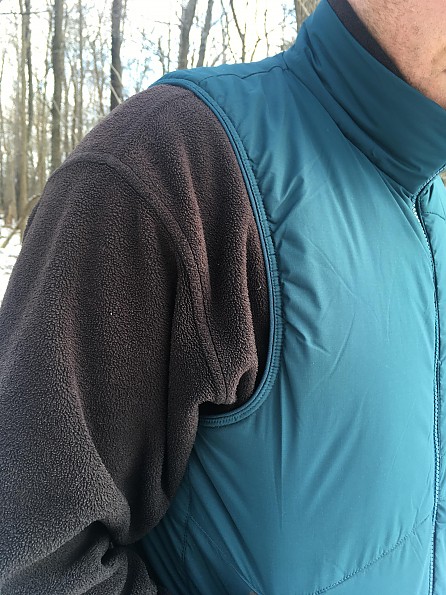
Cleaning Care:
The cleaning instructions are rather simple, just machine wash separately in cold water and either tumble dry on a low temperature or line dry. I’ve washed this a few times following the manufacturer’s instructions and had no issues.
Pockets:
The vest has a total of three spacious pockets—two for the hands and one on the chest—all of which have zipper enclosures. The hand pockets both have a soft fabric backing (a fabric called brushed tricot), making them extra comfortable to the touch. This is the same soft fabric found lining the inside of the collar. It's probably not necessary, but certainly nice to have! The left hand pocket also serves as an integrated stuff sack for the vest.
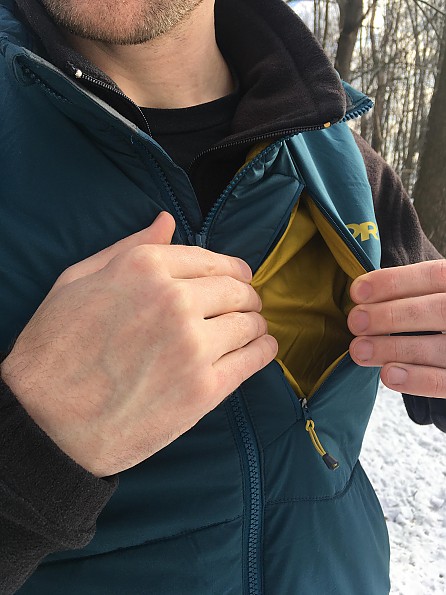
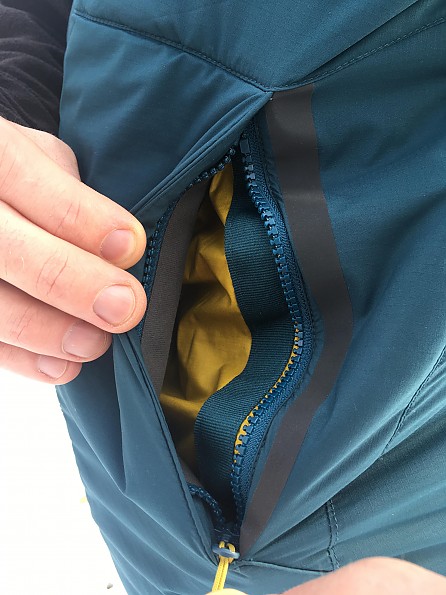
A Bonus Use—Camp Pillow:
Because of the soft fabric that lines the hand pockets, when the vest is stuffed into its own pocket and zippered shut, this vest can serve as a surprisingly comfortable camp pillow. It won’t match the size and comfort of my everynight bed pillow, but it could give some camping pillows on the market a run for their money.
I typically don’t take a pillow with me on trips, but rather rely on rolling up unworn (or lightly worn) layers to create a makeshift pillow (saves weight, at least in my mind). Having this vest packed serves better than any makeshift pillow I’ve been able to come up with so far. For this reason, I'm much more likely to pack it as a just-in-case layer on an overnight trip, knowing that I might wear it or I just use it as a comfy pillow.
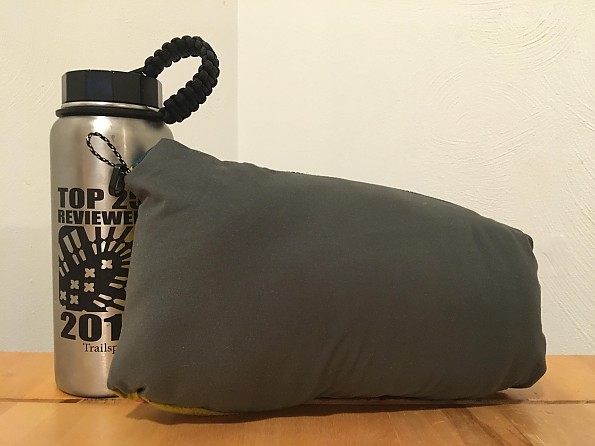
Summary:
The Outdoor Research Men’s Refuge Vest is a solid option for fall, winter, and spring. With quality features and comfortable fabric, it has become a go-to layer for me for the last five months. I’ve worn it during hiking, hunting, and general daily use, but I could also see it as a nice option for those who practice other winter activities like backcountry skiing, climbing, or snowshoeing.
Background
To stay active all 12 months of the year, regardless of temperature or weather conditions, requires I have a wide array of jackets and layers. Most of the vests I've worn in the past have been fleece or down.
Source: received for testing via the Trailspace Review Corps
(Sample for testing and review provided by Outdoor Research)
Your Review
You May Like
Specs
| Men's | |
|---|---|
| Price |
MSRP: $149.00 Historic Range: $71.52-$149.00 |
| Weight |
12.6 oz / 357 g |
| Fabric |
100% polyester 20Dx30D ripstop with mechanical stretch, VerticalX 100% polyester insulation 60 g/m2 |
| Center Back Length |
30.25 in / 77 cm |
| Fit |
Standard Fit |
| Women's | |
|---|---|
| Price |
MSRP: $149.00 Historic Range: $99.73-$149.00 |
| Weight |
10.7 oz / 303 g |
| Fabric |
100% polyester 20Dx30D ripstop with mechanical stretch, VerticalX 100% polyester insulation 60 g/m2 |
| Center Back Length |
27.25 in / 70 cm |
| Fit |
Standard Fit |


